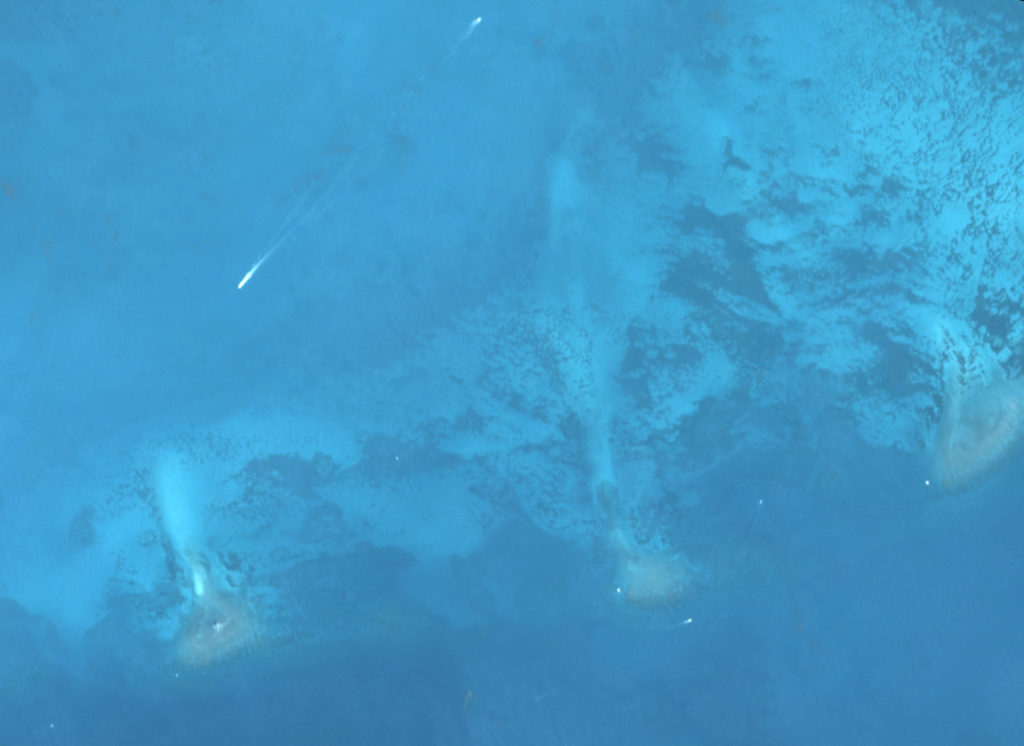Remote Sensing and the Science of Sound

Close your eyes and you will probably find––wherever you are––that your surroundings are not completely silent. A co-worker is typing, birds are singing, a radio or TV is playing, a car is honking or rushing by, crickets are chirping…
If you happened to be a fish cruising along the seafloor, your surroundings wouldn’t be completely silent either. The ocean is full of natural sound––from fish calling and bellowing, to dolphins and whales singing, to shrimp snapping their claws.
These undersea whistles, clicks and other sounds are the research purview of Geospatial Analytics Ph.D. student Shannon Ricci, an expert in underwater soundscapes. As part of her dissertation research, Ricci is developing new techniques to understand the impacts of boat traffic on natural sound beneath the sea.
Many studies have examined the effects of noise pollution on marine mammals’ hearing and behavior, Ricci says, but far fewer have measured impacts on fish and other animals.
“Do fish calls stop when a boat comes through?” Ricci asks. And if so, “what is the threshold of anthropogenic sound that we need to keep below, to reduce the impact on natural soundscapes?”
To answer these questions, Ricci is analyzing data from protected areas in the Florida Keys, where the National Oceanic and Atmospheric Administration (NOAA) has set up microphones that continuously record underwater sound. With that audio, Ricci will be able to compile thirty-second snapshots of fish activity, time-stamped and linked to specific locations on the seafloor.
How will she know when a boat was near a microphone, and so whether it had the potential to impact fish behavior?
Public tracking data aren’t available for the types of craft that frequent her study area, and so Ricci has developed a computer algorithm that can pick small boats out of satellite imagery.

“Models already exist to detect larger vessels” in satellite images, Ricci explains, but “as the object [that you want to detect] becomes smaller and smaller, it becomes harder.” Most of the traffic in her study area is comprised of small, shallow-water, recreational boats, and the model she trained to detect them has opened up “a dream list of projects” that weren’t possible before.
Ultimately, Ricci will match time series information from both the satellite and the microphone data to compare fish activity in the absence or presence of (little to lots of) maritime traffic––identifying how sound from boats in the Keys propagates through the water and how it impacts the behavior of the underwater wildlife. “The [region’s] sanctuaries are trying to protect these natural environments,” Ricci explains. Her work will help them answer the question “How do you protect sound?”
Ricci earned her master’s degree at NC State studying underwater soundscapes on the North Carolina coast. As a student in the Geospatial Analytics Ph.D. program, she is weaving more remote sensing and data science into her research, to better understand how noise impacts underwater wildlife across space and time. “If you know how to ask questions, and how to analyze data, you can apply that to so many different fields,” she says.

Ricci has a track record of detail-oriented problem-solving, a skill that has helped her to balance what she tweets about as #phdlife and #momlife. A full-time student, wife and mother, Ricci is also an officer in the Geospatial Graduate Student Organization and was recently honored for her hard work and academic excellence with the Center for Geospatial Analytics’ Gladys West (or “Hidden Figure”) Award.
Her advice for other graduate students who want to become parents? “There’s never going to be a perfect time,” she says. “If you’re drawn to having kids, it’s hard but it’s doable.”
The same could be said about tackling big questions in geospatial research. And dedicated students like Ricci are constantly rising to the challenge.
Ricci is advised by center faculty fellow Del Bohnenstiehl (Department of Marine, Earth and Atmospheric Sciences).
There are nine boats in the satellite image above, three in motion with a wake behind them and six stationary, visible as white dots. Did you find them all?


